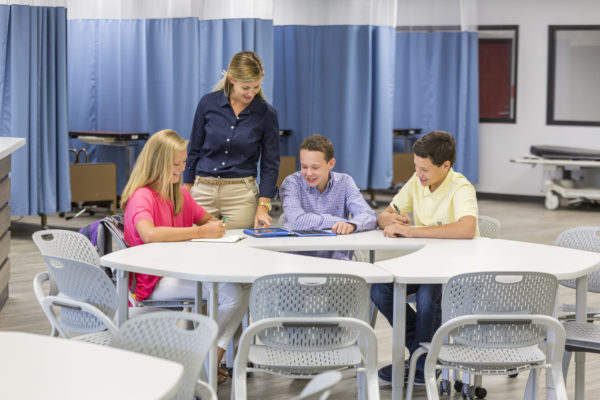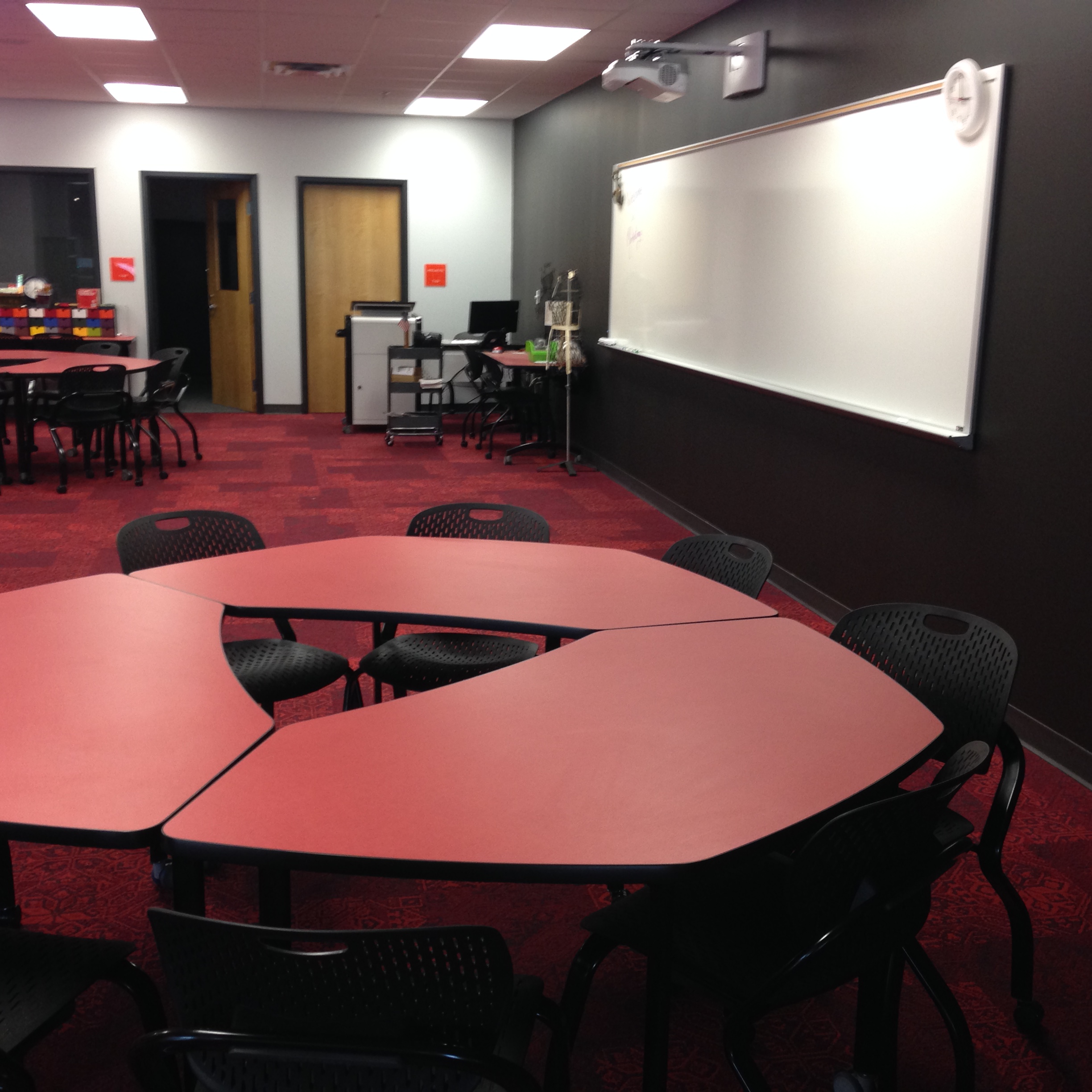For generations, most high schools have been designed with a cookie-cutter approach “that can be reproduced easily,” said Ashley Smith, who works with the architectural firm Smith Design Group. But that’s certainly not true of the new THINC College & Career Academy in LaGrange, Ga., which Smith helped design.
Housed in a building on the campus of West Georgia Technical College, THINC looks nothing like a traditional high school. Instead, it has the look and feel of a Google office building, with brightly colored carpet tiles, lots of glass walls, and stylish furniture that can be moved around easily to create flexible, collaborative workspaces.
Within those spaces, students work in teams to design and build parts for forestry machines, market a college radio station, or even launch their own start-up company. To complete these activities, they use the same technologies that professionals in those fields would use to do their jobs.
The school’s innovative design supports a more modern learning experience, in which students complete hands-on, collaborative projects. It’s a perfect example of active, 21st century learning, where students are fully engaged in their education rather than just passively listening to lectures.
See also: Is this model the future of college and career readiness?
For instance, in the engineering pathway, students work with engineers from construction equipment manufacturer Caterpillar to design and build parts for machines used in forestry. Students design the parts using AutoCAD, print them with a 3D printer, and when a part meets the engineers’ specifications, they use a computer numerical control machine to mill the part out of metal.
Next page: Research shows why flexible learning is critical
“They’ll be taking the part from design to actual use,” said Director Chris Williams, who serves as the school’s principal. “That’s what we want students to experience: taking a concept on a piece of paper and turning it into something they can use in the real world.”
The school’s design plays an important role in supporting this active learning model, right down to the furniture used in its classrooms and work spaces.
THINC’s planners wanted tables and chairs that could be moved around easily and arranged in flexible groupings to facilitate student collaboration. They approached a local company, Loy’s Office Supplies, which recommended the EDU 2.0, a line of furniture from the manufacturer Bretford.
“A key differentiator was the availability of power supplies in all of Bretford’s furniture,” said Chad Williams, vice president of Loy’s. With these power supplies readily available, students can plug in their digital devices and work comfortably wherever they happen to be sitting.
THINC students are allowed to use their own laptops, tablets, and smart phones in support of their learning. Throughout its classrooms and common areas, the school contains communal docking stations and tables with video monitors, where students can plug in their devices and share their screens as they work together on projects. Soft, comfortable chairs with built-in power outlets dot common areas and serve as places where students can work independently or in small groups.
Flexibility is key
How classrooms are designed can have a significant effect on how students learn, research suggests—and school leaders can encourage more active and engaging learning with the way their design their learning spaces.
Having flexible seating with readily available power supports many different modes of instruction and makes it easy for students and teachers to transition from whole-group lectures or discussions to small-group activities. Because there will be times when teachers will want to use each of these strategies in their classrooms, flexibility is important when designing learning spaces, says Nancy Van Note Chism, a former education professor at Indiana University.
“A group of learners should be able to move from listening to one speaker … to working in groups … to working independently,” she writes in Learning Spaces, a publication from the higher-education technology advocacy group EDUCAUSE. “While specialized places for each kind of activity … can accommodate each kind of work, the flow of activities is often immediate. It makes better sense to construct spaces capable of quick reconfiguration to support different kinds of activities, [using] moveable tables and chairs.”
A recent study by the University of Salford in England confirmed that classroom design can have a 25 percent impact, either positive or negative, on a student’s progress over the course of an academic year, and flexibility—defined as how easily a classroom’s furniture can be rearranged to support a variety of activities—was one of six key environmental factors that showed the most effect.
Arranging classroom furniture in ways that make it easy for students to pair off or work together in small groups not only supports active learning more readily—it also encourages this very behavior among students, while making it more likely that educators will use active learning strategies during instruction.
In a 2012 study at the University of Minnesota, research fellow D. Christopher Brooks observed two sections of a single course taught by the same instructor, with one section meeting in a traditional classroom space and the other meeting in a classroom designed specifically for active learning. He found that both the instructor and the students behaved differently, depending on the type of classroom they were in.
The traditional classroom had rows of tables facing the front of the room, while the active learning classroom was modeled after classrooms from North Carolina State University’s SCALE-UP initiative. In these classrooms, students were seated at large round tables that each hold nine students, making it easy for them to break off into groups of three for collaborative work.
Students in the active learning classroom—who had significantly lower ACT scores, on average—overcame the predicted achievement gap to earn the same average grade as their peers in the traditional classroom setting. Even more significantly, how each space was arranged affected the kinds of activities that occurred there, despite the fact that the instructor tried to use the same teaching methods and materials.
For instance, lecturing occurred in 77 percent of the observational periods in the traditional classroom setting and only 55 percent of the periods in the active classroom setting. What’s more, class discussions occurred in 48 percent more of the observational periods in the active learning classroom than in the traditional classroom.
Acquiring key 21st century skills “is enabled or disabled by the physical learning space,” said Sean Corcorran, general manager of Steelcase Education. He agreed that the physical environment students learn in can be optimized to support different kinds of activities, such as thinking, making, or sharing.
For sharing ideas, he said, it helps if students have the ability to share digital content or their screen at the simple push of a button. Google Cast could facilitate this by allowing users to project content from any device to a speaker or display using Google Chrome, and Steelcase sells a switching device, called media:scape, that allows a small group of users to project their screens to a shared display.
Design also affects senses and emotions
The design of a classroom not only influences the kinds of learning activities that take place there—it also can have a profound effect on how students feel, which affects their learning.
At the THINC Academy, “the whole space breathes this atmosphere of creativity and excitement,” Smith said. “We wanted to give the space a fun vibe that would be stimulating for teens.”
Saluda Trail Middle School in Rock Hill, S.C., received a 2015 Active Learning Center grant from Steelcase, which supported the physical transformation of seventh grade ELA teacher Julie Marshall’s classroom. The rows of static desks and chairs were replaced by brightly colored chairs on wheels and desks that could be grouped into different configurations easily to support more active and collaborative learning.
“We now have brought life into this classroom,” Marshall said. “I can roll right up next to [students] and they can roll up next to me [or] to each other. You can feel that bond that’s being created in each class. One of my kids said, ‘Our classroom is like the family dining room table.’ There is incredible engagement.”
Many of the school’s 850 students live in poverty, and they have been given the message their whole lives that they don’t matter, Marshall said. But that changed when their classroom was transformed.
“The first day they walked in, they could not believe what they were seeing,” she said. “They had never experienced this kind of environment before. And their first reaction was, ‘I cannot believe that somebody cared enough about me to give this to me.’ Every day they look forward to getting in the room.”
Keep reading: How to plan and create true flexible learning spaces
- TC- What student choice and agency actually looks like - November 15, 2016
- What student choice and agency actually looks like - November 14, 2016
- App of the Week: Science sensor meets your smartphone - November 14, 2016



